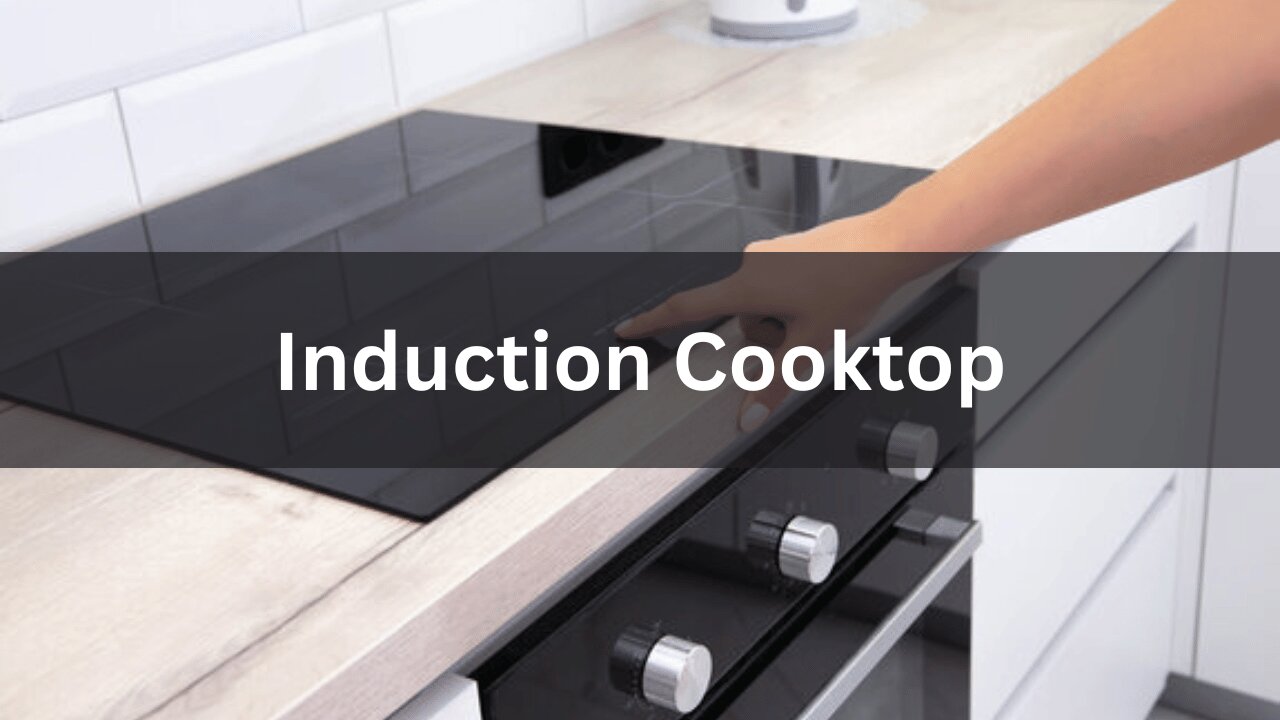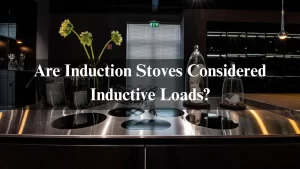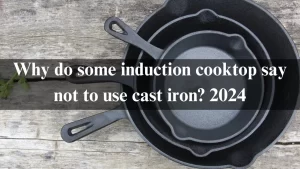Imagine a kitchen where cooking is faster, safer, and more efficient than ever before. Picture yourself effortlessly turning out gourmet meals with precise temperature control and enjoying the sleek, modern design of your cooking space. Welcome to the world of induction cooktops, where innovation meets excellence.
This blog post reveals the secrets behind this game-changing kitchen appliance. From their incredible energy efficiency to advanced safety features, induction cooktops are redefining how we cook. Join us as we explore the top models on the market and show why they are becoming must-have additions to every modern kitchen.
Stay tuned to discover how induction cooktops can transform your cooking experience and why they’re poised to be the future of kitchen technology.
Table of Contents
What Is An Induction Cooktop?
An induction cooktop is an electric stove that uses electromagnetism to heat cookware directly rather than relying on a heated surface. The cooktop surface stays cool, so you only need to heat the cookware itself.
History of induction cooktop and who invented it?
The history of induction cooktops is marked by significant advancements in technology and cooking efficiency. The concept of induction cooking, which relies on electromagnetic fields to heat cookware directly, dates back to the early 20th century.
Early Development
Nikola Tesla and Electromagnetic Induction:
- The principles underlying induction cooking were first demonstrated by Nikola Tesla in the late 19th century through his work on electromagnetic induction.
Commercial Introduction
Westinghouse and Early Prototypes:
- In the 1930s, the Westinghouse Electric Corporation showcased an early induction cooking prototype at a trade show in Chicago. This prototype demonstrated the potential of induction cooking but was not commercially viable due to the limitations of the technologand y the lack of suitable cookware.
Modern Advancements
1960s-1970s:
- The technology saw significant advancements in the 1960s and 1970s. European and American companies, including Frigidaire, conducted further research and development to improve induction cooktops’ efficiency and reliability.
First Commercial Models:
- In 1973, Frigidaire introduced the first commercially available induction cooktop in the United States. However, it was expensive and did not gain widespread popularity due to the high cost and limited availability of compatible cookware.
Popularization
Late 20th Century:
- Throughout the 1980s and 1990s, continued advancements in electronics and materials made induction cooktops more affordable and reliable. Improved power electronics, such as insulated-gate bipolar transistors (IGBTs), played a crucial role in enhancing the performance and reducing the cost of induction cooktops.
21st Century:
- By the early 2000s, induction cooktops became more popular in both domestic and commercial kitchens due to their efficiency, precise temperature control, and safety features. Major appliance manufacturers, including Bosch, Siemens, and Samsung, began producing a wide range of induction cooktops.
How Do Induction Cooktops Work?
Induction cooktops use the power of electromagnetism to heat your cookware directly rather than the cooktop surface itself. Here is a breakdown of the process:
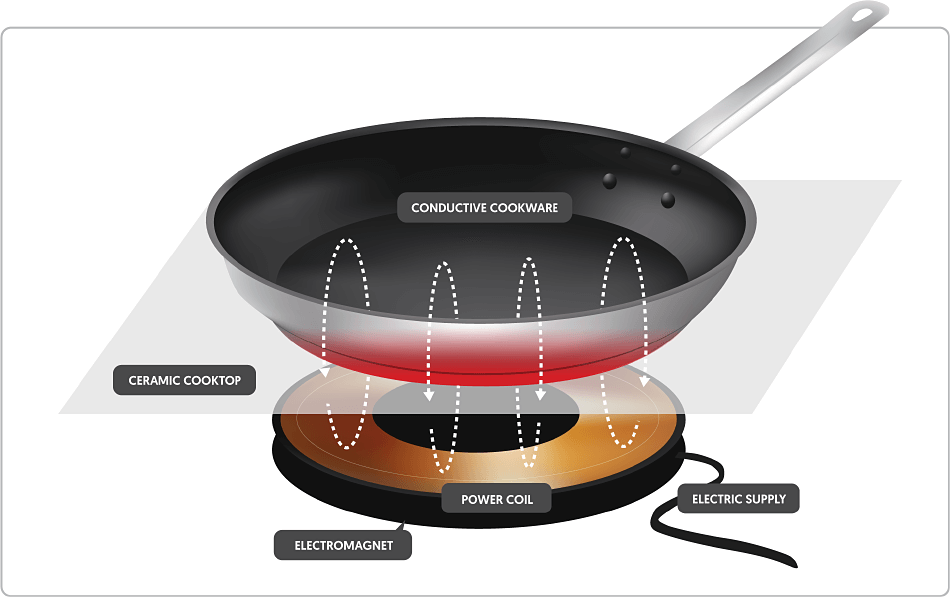
- Coil: Beneath the smooth glass ceramic surface is a coil of copper wire.
- Electromagnetic field: When you turn on the cooktop, an alternating current flows through the coil, creating a rapidly changing magnetic field.
- Compatible cookware: Cookware should be made of ferrous materials with a magnetic base, such as cast iron or stainless steel.
- Eddy current: A magnetic field interacts with ferrous cookware, inducing an electric current within the pot or pan. These are called eddy currents.
- Heat Generation: The cookware’s resistance to these sharp currents generates heat, heating the pan and cooking your food.
Top 7 Types of Induction cooktop
Induction cooktops are a popular choice for modern kitchens due to their energy efficiency and safety. They use electromagnetic fields to heat cookware directly, rather than heating a hot surface. This makes them faster to heat up and cool down, and they are also much easier to clean. Induction cooktops come in a variety of types to suit different needs and kitchen layouts. Here’s a breakdown of the most common ones:
- Built-In Induction Cooktop:
These are the most common type of induction cooktop. They are designed to be permanently installed into your countertop, and they come in a variety of sizes and configurations to fit your kitchen. Built-in induction cooktops typically have a sleek, modern look and can be a great way to add style and functionality to your kitchen.
- Portable Induction Cooktop:
Portable induction cooktops are a great option for people who live in small apartments or who want the flexibility to be able to cook anywhere. They are small and lightweight, and they can be plugged into any standard outlet. Portable induction cooktops typically only have one or two cooking zones, but they are still a great option for occasional use.
- Slide-In Induction Cooktop:
Slide-in induction cooktops are similar to built-in induction cooktops, but they have a finished front that allows them to slide into a cutout in your countertop. This can give your kitchen a more built-in look without the need for permanent installation.
- Drop-In Induction Cooktop:
Drop-in induction cooktops are also similar to built-in induction cooktops, but they have unfinished edges that sit on top of your countertop. They are a good option for people who want the look of a built-in cooktop without the need for permanent installation.
- Modular Induction Cooktop:
Modular induction cooktops are individual induction cooking elements that can be mixed and matched to create a custom cooktop configuration. This is a great option for people who want a lot of flexibility in their kitchen layout.
- Double Induction Cooktop:
Double induction cooktops are simply induction cooktops that have two cooking zones. This is a good option for people who want a cooktop that is larger than a portable induction cooktop but still doesn’t take up a lot of space.
- Induction Cooktop with Downdraft Ventilation:
Induction cooktops with downdraft ventilation are a great option for people who want to keep their kitchen free of smoke and odors. The downdraft ventilation system is built into the cooktop and sucks up smoke and odors as you cook.
Pro of Induction Cooktops
Induction cooktops have several advantages over conventional electric or gas cooktops. Here are some key benefits:
- Speed Demon: Induction reigns supreme in heating speed. Because the heat is generated directly in the cookware, induction cooktops heat up much faster than other cooktops, boiling water in a fraction of the time.
- Precision Maestro: Induction offers unparalleled temperature control. You can adjust the heat precisely, making it ideal for delicate cooking methods such as simmering or achieving the perfect sear.
- Safety First: Unlike gas or traditional electric cooktops, the cooktop’s surface stays cool. It significantly reduces the risk of accidental burns, especially in households with small children or pets.
- Cleaning Champion: Induction cooktops are champions of easy cleaning. The smooth glass surface stays cool, prevents spills from burning, and makes cleaning a breeze.
- Energy Saving: Induction cooktops are energy-efficient appliances. Since heat is generated directly in the cookware, minimal energy is wasted heating the surrounding area. It translates into lower energy bills and reduced environmental impact.
- Extra perks: Some induction cooktops have features like automatic pan detection, timers, and boost functions for extra heating power.
Induction cooktops use magnets to heat your pan directly, not the cooktop itself. That translates to faster cooking, precise temperature control, cool surfaces for safety, and easy cleaning. However, they are more expensive and require magnetic cookware.
Cons Of Induction Cooktops
While revolutionizing kitchens with speed and safety features, induction cooktops have some downsides to consider before replacing your trusty gas burner or electric coil range. Here’s a closer look at the potential pitfalls:
- Cost factor: Induction cooktops are more expensive than conventional electric or gas cooktops. The upfront investment can be significant, especially for high-end models with advanced features.
- Check Cookware Compatibility: Unlike traditional ranges that accommodate almost any cookware, induction cooktops are picky eaters. They only work with pots and pans with a ferrous metal base, usually stainless steel or cast iron. That means you may need to replace some or all of your cookware, adding to the overall cost.
- The Buzz Kill: Some induction cooktops, especially low-quality models or when using substandard cookware, may make a slight hum during operation. It may be a minor annoyance for some cooks, but it can be a deal breaker for others.
- Power Outage Blues: Induction cooktops are entirely dependent on electricity. If the power goes out, so do your cooking plans. Unlike gas cooktops that can still work with a match or lighter, induction offers no alternative during a power outage.
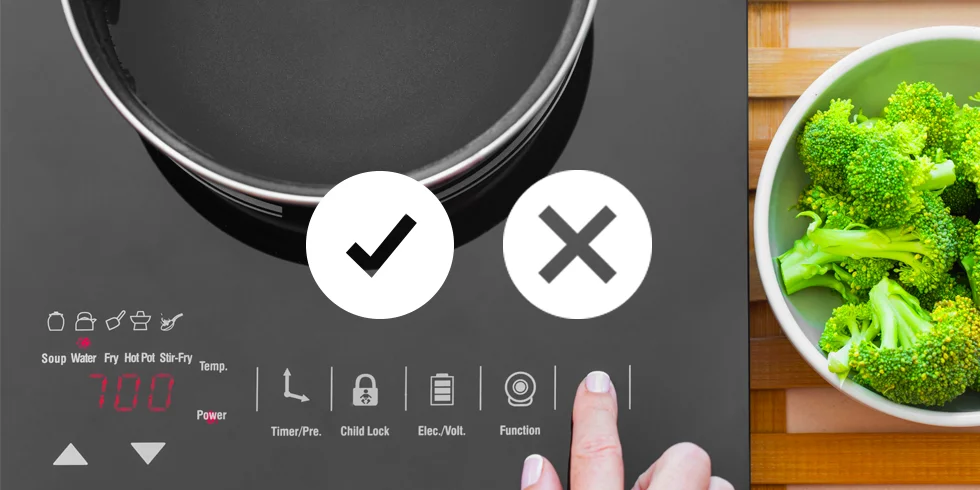
- Heat zone mystery: While some induction cooktops boast clearly defined cooking zones with specific sizes and heat levels, others’ heating levels can be more ambiguous. That may lead to some trial and error with pan placement to achieve the desired heat distribution for different-sized pots and pans.
- Scratch susceptibility: Though praised for their easy cleaning, induction cooktops’ smooth glass surface can be prone to scratches and cracks if not handled carefully. Over time, using cookware with rough bottles or improper cleaning techniques can lead to a less aesthetically pleasing cooktop.
Induction cooktops are excellent (literally) and fast but could be better: expensive, require new cookware, can buzz, and won’t work during a power outage.
How To Use An Induction Cooktop?
Here’s how to use an induction cooktop:
- Gear up: Ensure you have the right tools before firing up the cooktop. Induction cooktops only work with cookware that has a ferrous metal base, usually cast iron or stainless steel, with a magnetic bottom. You can test your existing cookware by placing a magnet on the base – if it sticks, it will work on induction.
- Power On: Locate the Power button on the control panel and press it to turn on the cooktop. Each model may have slight variations, so consult your owner’s manual if needed.
- Zone Selection: Most cooktops have designated cooking zones with different sizes. Choose the zone that best fits your cookware size for optimal heat distribution.
- Pan Placement: Place your compatible cookware on the chosen cooking zone. The cooktop should automatically detect the pan and light the corresponding zone.
- Heat it: Use the control panel to adjust the heat setting. Induction cooktops typically offer a range of settings from simmering to high heat, allowing precise temperature control. Some models may use touch controls with + and – buttons, while others may have knobs.
- Cooking time: Induction cooktops heat up quickly, so adjust your cooking times accordingly. Water boils significantly faster than conventional electric or gas ranges.
- Safety First: Remember, the cooktop surface stays relatively calm, but the cookware will get hotter as it cooks your food. Use oven mitts when handling hot pots and pans.
- Cleaning: Induction cooktops are champions of easy cleaning. While the cooktop is hot, wipe the stains with a damp cloth. Avoid using harsh chemicals or abrasive cleaners on smooth glass surfaces.
- Power Down: After cooking, turn off the cooktop using the designated power button. Some models may have an automatic shut-off feature after a period of inactivity.
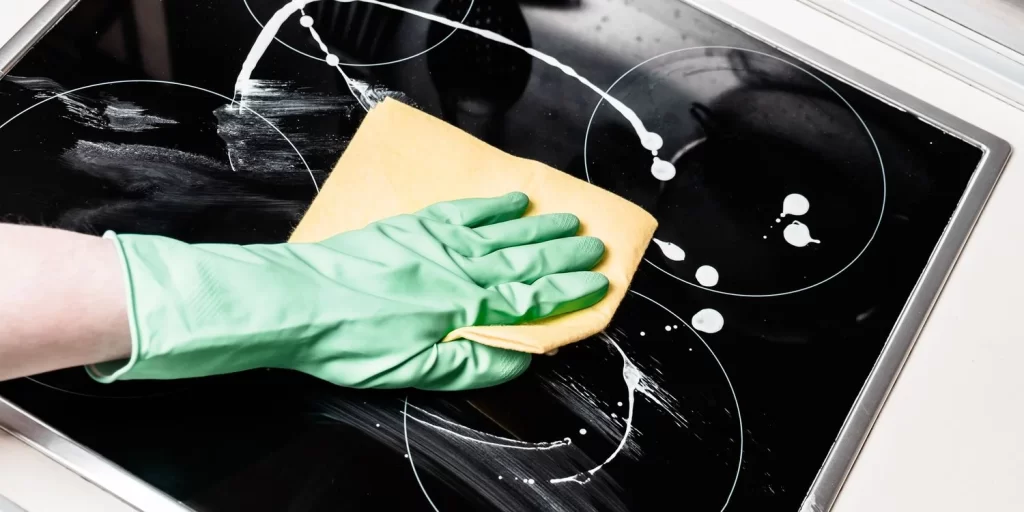
Bonus Tip: Many induction cooktops come with extra features like timers, boost functions for extra heating power, and automatic pan detection that adjusts the cooking zone to the size of the pan. Consult your owner’s manual to discover all the features your particular model offers.
Moreover, Induction cooktops heat your pans directly with magnets, making them super fast and safe. The cooktop stays cool and is easy to clean, but you’ll need unique magnetic cookware. They can be pricier than traditional stoves but offer a sleek and efficient cooking experience. Keep in mind all these points when you are choosing Induction cooktop.
Features Of Induction Cooktops: A Modern Kitchen Essentials
Induction cooktops are transforming kitchens worldwide, offering a smooth, efficient, and safe cooking experience. If you’re considering upgrading your kitchen or want to know about the latest developments in cooking technology, here’s a comprehensive look at the key features that make them must-have appliances.
- Energy efficiency
The most energy-efficient induction cooktops convert up to 90% of their energy into heat. This efficiency is due to the direct transfer of power from the cooktop to the cookware, reducing energy waste and significantly reducing cooking times compared to traditional gas or electric cooktop.
- Accurate temperature control
One of the standout features of induction cooktops is their precise temperature control. They allow quick adjustments to heat levels, providing consistent and accurate cooking results. This feature is particularly beneficial for delicate cooking tasks that require specific temperatures.
- Fast Heating
Induction cooktops heat up very quickly. Because the heat is generated directly in the cookware, they can boil water and heat food much faster than a traditional stove, saving significant time in food preparation.
- Safety Features
Safety is a top focus with induction cooktops. They stay cool to the touch because heat only develops in the cookware. In addition, most induction cooktops have automatic shut-off features, child lock functions, and overheat protection, making them a safe choice for households with children.
- Ease Of Cleaning
The smooth, flat surface of induction cooktops makes them easy to clean. Because the cooktop doesn’t heat up, spills and splatters don’t burn onto the surface, allowing quick wiping with a damp cloth.
- Morden Design
Induction cooktops offer a sleek, modern design that can enhance the aesthetics of any kitchen. Their smooth, flat surfaces provide a clean look, which can be especially appealing in existing kitchen designs.
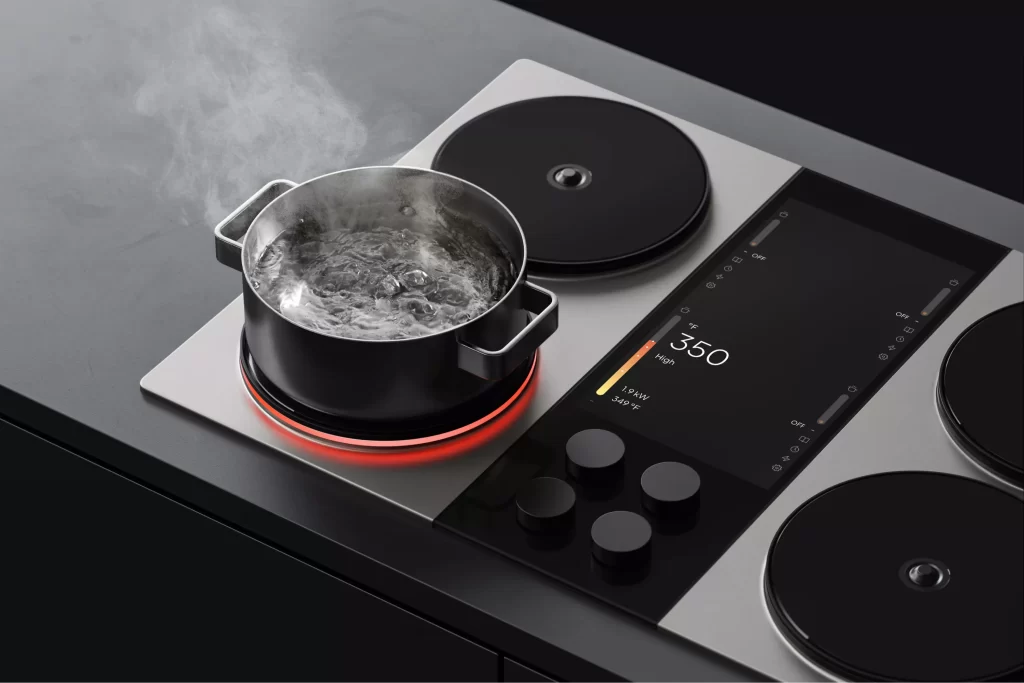
- Versatility
Many induction cooktops have multiple cooking zones and adjustable cooking surfaces, allowing cookware of different sizes and shapes to be used. Some modern models also have bridge components that accommodate larger or uniquely shaped pans.
- Smart Technology Integration
The latest induction cooktops often use innovative technology. Features such as touch controls, digital displays, timers, and Wi-Fi connectivity for remote operation via smartphone apps are becoming the norm. This integration of innovative technology allows for a richer and more customized cooking experience.
- Eco-Friendly
Induction cooktops are more environmentally friendly than their gas or electric counterparts because they are more energy efficient and reduce cooking times. They help reduce energy consumption and reduce a household’s carbon footprint.
- Noise Level
Although induction cooktops are generally quieter than gas stoves, they produce a slight hum or buzz, especially in high-power settings. This noise comes from the electromagnetic energy of the unit and the cooling fan. However, this is usually minimal and not disruptive.
If you want to read the features of induction cooktop in detail you can read this article : Top 10 Features Of An Induction cooktop Latest Info 2024
What is an induction stove?
An induction cooktop, also called an induction stove, uses magnetic fields to directly heat your cookware. Unlike gas or traditional electric cooktops, the cooktop surface itself stays cool. This makes them safer and easier to clean. Induction cooktops are faster to heat up, offer precise temperature control, but require special cookware and tend to be more expensive upfront.
Related Article : Why Is My Induction Stove Giving An Electric Shock? Latest Info 2024
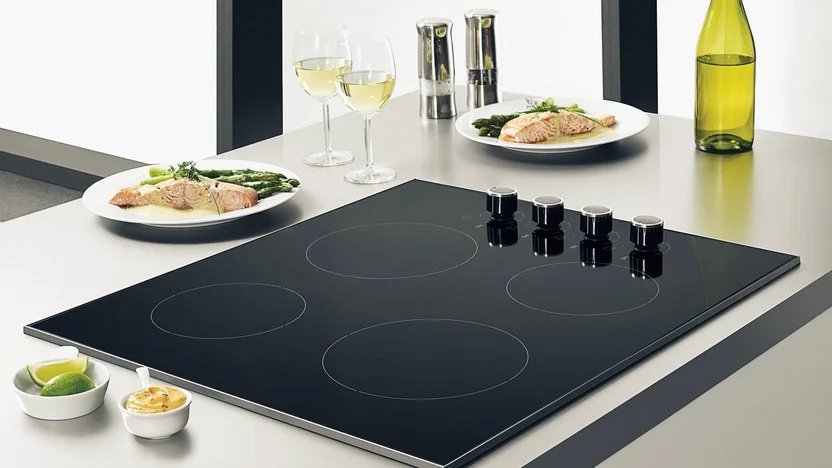
How We Selected the Best Induction Cooktops
Choosing the best induction cooktops requires consideration of various factors to ensure that we only recommend high-performance models. Our selection process is thorough and detailed, covering some criteria to guarantee that our selections meet the highest quality, performance, and customer satisfaction standards. Here’s an insight into how we chose the best induction cooktops for our readers.
- Performance and Efficiency
- We prefer cooktops with quick heat-up times, precise temperature control, and high energy conversion rates for consistent and high cooking efficiency.
- User Reviews and Rating
- We explored hundreds of customer reviews and ratings to gauge customer satisfaction and identify common problems, always focusing on top-rated models.
- Safety Features
- Select cooktops with built-in safety features such as automatic shut-off, child lock, and overheat defense to ensure user safety and peace of mind.
- Easy to Clean and Use
- User-friendly interfaces, control options, and overall design are considered, and models with sleek, smooth surfaces that are easy to clean are favored.
- Build Durability and Quality
- Estimated materials, build quality, and sturdiness favor models with high-quality components and compact construction.
- Aesthetics and Design
- Evaluate the design, finish, and overall appearance of cooktops to ensure that they enhance the visual appeal of any kitchen.
- Versatility and Features
- We analyzed the number of cooking zones, cookware compatibility, and additional features such as bridge elements, touch controls, digital displays, and innovative technology integration.
- Brand Reputation and Warranty
- Preferred brands known for quality and customer service and backed by comprehensive coverage accepted recommended warranty terms.
- Price and value for money
- Compare the price of each cooktop with its features, performance, and overall quality, including both high-end and budget-friendly options, to ensure a good value.
- Expert Reviews and Recommendations
- We consulted professional reviews and recommendations from trusted sources, including professional chefs and appliance experts, to identify the best-performing models.
Tips For Taking Care Of Your Induction Cooktops
Here are some essential tips to keep your induction cooktop in tip-top shape:
- The right tools: Use only cookware with a ferrous metal base, such as cast iron or stainless steel with a magnetic bottom. The magnet test is your friend – if it sticks, the pan works!
- Clean-up curve: Wipe spills and splatters with a damp cloth while the cooktop is hot. It will prevent them from becoming a nightmare to bake and remove later.
- Gentle touch: Avoid harsh chemicals, abrasive scrubbers, and sharp objects. These can scratch the smooth glass surface of your cooktop.
- Do not lift: Sliding pots and pans can scratch the surface. Always lift your cookware when moving around the cooktop.
- Cool before cleaning: Do not douse a hot cooktop with water. Allow it to cool completely before cleaning to avoid any possible warping or damage.
- Skip the submersion: Unlike some stoves, induction cooktops are not waterproof. Avoid submerging them in water or spilling large amounts of liquid near the control panel.
- Read the manual: Your cooktop’s manual is your best friend. It will contain specific cleaning recommendations and instructions for your particular model.
By following these simple tips, you can ensure your induction cooktop looks sleek and functions flawlessly for years to come.
My persoanl experince of installation of induction cooktop is very well. I install my induction cooktop 2 months ago it is very easy to use and clean. It have almost all the unique feature that we demand in our cooking the main one I noticed it boiled the in only 1 to 2 minutes. Therefore i like it more than other cooktop.
Comparing Induction with Gas and Electric Stoves
| Feature | Induction Cooktop | Gas Stove | Electric Stove |
| Heating Speed | Very Fast | Moderate | Slow |
| Energy Efficiency | High (90-95% efficient) | Low (30-40% efficient) | Moderate (70-80% efficient) |
| Safety | High (cool to touch) | Low (open flame) | Moderate (hot surface) |
| Control Precision | Excellent | Good | Good |
| Ease of Cleaning | Very Easy (flat surface) | Moderate (grates | Easy (flat surface) |
Related Articles:
Everything to Know About Induction Cooktops
Induction VS Gas Cooktop. Which One Is Best? Info 2024
Why Doesn’t Cookware Stick To Induction Cooktops? In 2024
Conclusion
Induction cooktops are revolutionizing our cooking, offering unparalleled speed, precision, and safety. Imagine a kitchen where cooking is faster, more efficient, safer, and easier to clean. With their sleek, modern design, induction cooktops add a touch of elegance to any kitchen, making them a must-have for contemporary homes.
From their impressive energy efficiency and advanced safety features to their user-friendly interface and intelligent technology integration, induction cooktops are setting new standards in kitchen appliances. While they come with caveats, such as the need for compatible cookware and a higher initial cost, their advantages far outweigh these minor drawbacks.
Whether you are a professional chef or a home cook, induction cooktops promise to elevate your cooking experience. They provide precise temperature control and high heat to change your food preparation. By choosing an induction cooktop, you’re not just upgrading your kitchen but embracing the future of cooking technology.
As you explore the top models and consider making the switch, remember that induction cooktops offer more than convenience and efficiency. They represent a commitment to modern, eco-friendly living, combining high performance with stylish design. So, discover how induction cooktops can make your cooking adventures faster, safer, and more enjoyable.
FAQS
Do I need special cookware for an induction cooktop?
Yes, your cookware needs to be magnetic, meaning it should have a ferromagnetic base. You can test this by seeing if a magnet sticks to the bottom of your pan.
Can an induction cooktop cause electrical interference with other devices?
While induction cooktops generate an electromagnetic field, they are designed to comply with safety standards that prevent interference with other household electronics.
Is an induction cooktop worth the investment?
Absolutely. The efficiency, precision, and safety features of induction cooktops make them a worthwhile investment, especially for those who cook regularly.
Are induction cooktops difficult to install?
Installation can be straightforward if you already have a 220V power outlet. However, if you need to upgrade your electrical system, it’s best to consult a professional electrician.

